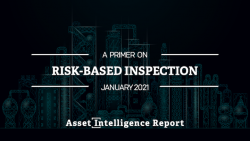Sponsored by ![]()
Overview
Risk-Based Inspection (RBI) is an analysis methodology used to identify and understand risk, risk drivers, and where equipment is in its lifecycle in order to focus inspection efforts and resources on higher-risk assets. While traditional prescriptive inspection methodologies approach all assets with set intervals, an RBI methodology instead recommends inspection or other activities based on each asset’s calculated level of risk.
According to API RP 580, RBI is primarily focused on maintaining the mechanical integrity of pressure equipment items and minimizing the risks associated with of loss of containment due to deterioration. A properly-implemented RBI program categorizes individual pieces of equipment by their risks, prioritizes inspection efforts, and provides guidance for risk mitigation efforts, such as changes in materials of construction, the addition of linings, changes in operating conditions, etc.
This Asset Intelligence Report contains the following sections:
- Overview of RBI
- Risk Matrix and Uninspectable Risk
- Reassessment and Evergreening
- RBI Implementation Best Practices
- People
- Process
- Technology
- References
As with other Asset Intelligence Reports, this document is not intended to serve as a comprehensive guide, but rather an introductory primer on the principles of RBI, RBI implementation, and maintaining an RBI program. Since the information is provided in a condensed format, we recommend printing and laminating copies that can be referenced by you and your co-workers at your convenience.
Log in or register below to download this free primer on Risk Based Inspection.















